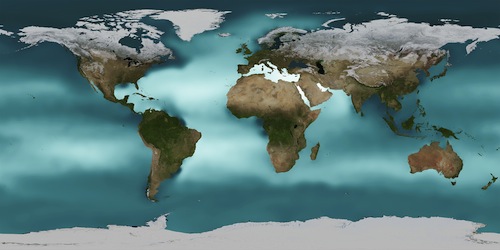Featured Stories, MIT, WHOI | September 27, 2012
An Ocean’s Perspective on the Changing Water Cycle
By Genevieve Wanucha
As the climate warms, global rainfall and evaporation, i.e. the water cycle, changes with it. According to current climate models, an intensification of the global water cycle has already developed in response to the observed 0.5 °C warming of Earth’s surface over the past 50 years. Further global intensification, models show, will add more moisture to the warmer air, which could fuel precipitation extremes. Now, an effort is underway to predict the future water cycle. Climate modelers are turning to the ocean for answers. After all, most of the evaporation and precipitation of the water cycle happens over the oceans.
Measuring the Salt
Ray Schmitt, a senior scientist at WHOI and others have long observed that changes in evaporation and precipitation patterns leave a fingerprint in the salt content of surface sea waters. The areas receiving more rainfall have become fresher, whereas the spots in the ocean where evaporation has increased have turned saltier over time, or “oceanic deserts,” as Schmitt called them at “The Ocean and Earth’s Changing Water Cycle,” a conference held at Woods Hole Oceanographic Institution in May. As such, “salinity is turning out to be a very good indicator of what’s happening in the water cycle,” said Schmitt. In fact, the most recent 2012 analysis of salinity records suggests a direct link between water cycle intensification and climate change.

For this study, Paul Durack from the Lawrence Livermore National Laboratory, and his team combined 50-year observed global changes in ocean surface salinity with data from global climate models. They found a rate of ocean intensification twice as large as the current predictions. If Durack’s model holds true, the predicted 2 to 3 degree rise in temperature by the end of the century could produce a 16-24% acceleration in the water cycle. “That is the best evidence we have for a changing water cycle over the past 50 years,” said Schmitt. “We are seeing a surprisingly large change. And we have to deal with the consequences.” However, there are limits to what such a model can reveal about potential weather extremes.
Although climate models can make robust predictions of broad scale changes over long time periods, “when you go to a more local level,” says Paul O’Gorman, assistant MIT professor and climate modeler in PAOC, “it’s quite hard to know whether you would see an increase or decrease in precipitation.” Nevertheless, Durack’s finding suggests that current models are underrating the impact of climate change on the water cycle. “Whether or not the models do underestimate water cycle changes from climate change–I don’t think we know for sure,” says O’Gorman, “but it’s important to be aware that it is possible they are underestimating.” Indeed, climate predictions will inform future infrastructure planning for extreme weather.

To better understand climate change, O’Gorman is keeping an eye on the tight links between ocean, atmosphere, and land. At the WHOI conference, he added to the story. In his climate model, he found that the response to climate change differs over the land versus over the ocean. “In a warming climate, the temperature goes up over land and ocean,” says O’Gorman, “but the land heats up quicker than the ocean.” His results show this pattern occurs globally and over a wide range of climates. When land loses its moisture, the lack of evaporative cooling contributes further to the land warming. Over time, the contrast in temperature and relative humidity builds up between land and ocean. As for the specific effects of those atmospheric shifts on the weather and rainfall we experience, O’Gorman and his students are working to quantify them now.
Lessons from the Ocean Floor
For the long view on climate-linked water cycle change, we must turn to data on past climatic conditions. David McGee, a paleoclimatologist at MIT’s PAOC, studies ancient accumulations of dust on the ocean floors off the Sahara Desert to understand why the formerly grassy area dried up over the past 10,000 years. By dating the layers in sediment cores that have been hauled up two kilometers from the ocean floor, he can estimate how quickly dust built up over time and therefore how wet or dry North Africa was. He is trying to understand a long-standing mystery within the sediment cores.
Researchers are fairly certain that gradual changes in Earth’s orbit changed the amount of incoming sunlight during the local summer, which decreased the strength of the monsoon. “So, you would expect it to have gotten dustier and dustier as the land got drier,” said McGee. “Instead, the dust was low and, very quickly, possibly as quickly as a few decades, the dust coming out of Africa greatly increased.” His lab is now trying to find out why such a quick drying happened during very slow climate change. McGee points out that these paleoclimate records “give us questions to investigate with models to understand why monsoons don’t fail in a gradual way, and why there might be important steps of no return along the way.” Of course, no direct links can be drawn between past climates and the weather of the current century.
On one hand, new evidence predicts an unexpectedly intense global water cycle response to climate change. On the other, the actual effect of climate change on hurricanes and droughts in the United States’ near future is not an easy forecast with our current models. “That’s the state of the science at the moment,” says O’Gorman. But as researchers at MIT, WHOI, and beyond build more sensitive models of the future water cycle or validate current models with more exact climate records of the past, the oceans will be at the center of the investigation–exactly why Oceans at MIT looks forward to reporting on every development.








